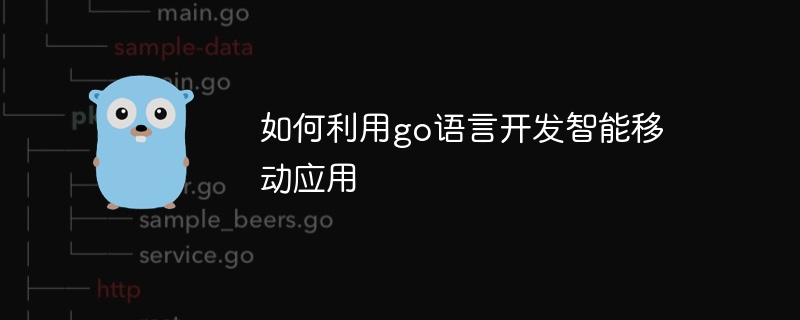Home >Backend Development >Golang >How to use go language to develop smart mobile applications
How to use go language to develop smart mobile applications
- 王林Original
- 2024-03-23 12:33:03512browse

How to use Go language to develop smart mobile applications
In today's era of rapid digital development, mobile applications have become an indispensable part of people's daily lives. With the continuous advancement of artificial intelligence technology, smart mobile applications have gradually attracted public attention and demand. Go language, as an efficient, concise and superior concurrency programming language, is increasingly favored by developers. This article will introduce how to use Go language to develop smart mobile applications, including specific code examples.
1. Choose a suitable mobile application development framework
Before using Go language to develop mobile applications, you first need to choose a suitable mobile application development framework. Currently popular ones include Flutter, React Native, etc. These frameworks provide rich APIs and tools to help developers quickly build cross-platform mobile applications.
2. Use Go language to write back-end services
Smart mobile applications usually need to interact with back-end services for data, so they need to use Go language to write back-end services. The following is a simple Go language backend service example:
package main
import (
"fmt"
"net/http"
)
func helloHandler(w http.ResponseWriter, r *http.Request) {
fmt.Fprintf(w, "Hello, World!")
}
func main() {
http.HandleFunc("/", helloHandler)
http.ListenAndServe(":8080", nil)
}This code creates a simple HTTP server, listening on port 8080. When an HTTP request is received, it will return "Hello, World!" the response to.
3. Use Go language to develop machine learning models
Smart mobile applications usually need to use machine learning algorithms to implement functions such as intelligent recommendations and intelligent conversations. There are some excellent machine learning libraries in Go language, such as GoLearn, Gorgonia, etc. The following is a simple example of using the GoLearn library to implement a linear regression model:
package main
import (
"fmt"
"github.com/sjwhitworth/golearn/base"
"github.com/sjwhitworth/golearn/linear_models"
)
func main() {
// 创建一个新的空数据集
data := base.NewDenseInstances()
// 为数据集添加样本数据
data.AddClassAttrValues(base.AllClassAttributes(), []string{"A", "B", "C", "A"})
data.AddClassAttrValues([]int{0, 1, 2}, []float64{1.0, 2.0, 3.0})
// 创建线性回归模型
lr := linear_models.NewLinearRegression()
lr.Fit(data)
// 预测新数据
pred, _ := lr.Predict(base.NewInstance(), nil)
fmt.Println(pred)
}The above code implements a simple linear regression model through the GoLearn library, which can be used for data prediction in smart mobile applications.
4. Integrate the front-end interface
Finally, the back-end services and machine learning models need to be integrated into the front-end interface of the mobile application. You can use the API provided by the framework for data interaction and display. Here we take the Flutter framework as an example. The example is as follows:
import 'package:flutter/material.dart';
import 'package:http/http.dart' as http;
void main() {
runApp(MaterialApp(
home: MyHomePage(),
));
}
class MyHomePage extends StatelessWidget {
@override
Widget build(BuildContext context) {
return Scaffold(
appBar: AppBar(
title: Text('Hello, World!'),
),
body: Center(
child: FutureBuilder<String>(
future: fetchHello(),
builder: (context, snapshot) {
if (snapshot.hasData) {
return Text(snapshot.data);
} else {
return CircularProgressIndicator();
}
},
),
),
);
}
Future<String> fetchHello() async {
final response = await http.get('http://localhost:8080');
return response.body;
}
}The above example code implements a simple mobile application interface through the Flutter framework and interacts with the back-end service for data, displaying the response result of "Hello, World!" .
Summary
Through the above steps, we can use the Go language to develop smart mobile applications and combine back-end services and machine learning models to achieve more intelligent and intelligent functions. Of course, you may encounter various challenges and difficulties during the development process, but as long as you have sufficient time and energy, I believe you will be able to successfully develop excellent smart mobile applications.
The above is the detailed content of How to use go language to develop smart mobile applications. For more information, please follow other related articles on the PHP Chinese website!
Related articles
See more- Detailed introduction to the 12 major features of HTML5 mobile application development
- What is the difference between go language and Java language?
- What editor to use for go language?
- Microsoft plans to introduce artificial intelligence capabilities to MS Paint?
- Java development experience sharing from scratch: building mobile application backend

